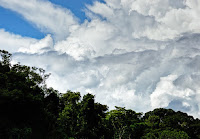Rising temperatures will not themselves spell disaster for the world’s rainforests. It is the droughts and unpredictable rainfall patterns, which climate change is already worsening, that will settle the forests’ fate before the century ends, according to a new book.
Claude Martin, who has worked in tropical rainforest conservation since the 1970s, is author of On the Edge, commissioned by the Club of Rome, which published the seminal Limits to Growth report in 1972. Since then, nearly 50% of the world’s forest cover has disappeared.
Martin, a former director-general of WWF International, recognises that there are many drivers of forest damage and destruction - including the pressures of the global economy for animal feed and food for humans, and the worldwide demand for biofuels.
Essential ecosystem
Acknowledging the progress made in science and conservation, he reminds his readers that the forests are not just huge repositories of biodiversity, but an essential ecosystem providing everyone on the planet with fresh water, clean air and climate regulation.
Evaluating the impact of climate change on rainforests means focusing on the length of dry seasons and water stress, rather than temperature, Martin writes.
The likeliest cause of forest collapse and severe risks of reaching a tipping point is not temperature rise, but the change from the dependable rainfall patterns of the past, and the probability of increasing droughts and forest fires.
He sees a likelihood of drought and fires increasing - not least in the Amazon - because of the way in which climate change is fueling El Niño and La Niña, the twin periodic temperature disruptions that occur every few years in the eastern Pacific Ocean.
Read more at Rainforests Are Left on Edge of Destruction

No comments:
Post a Comment